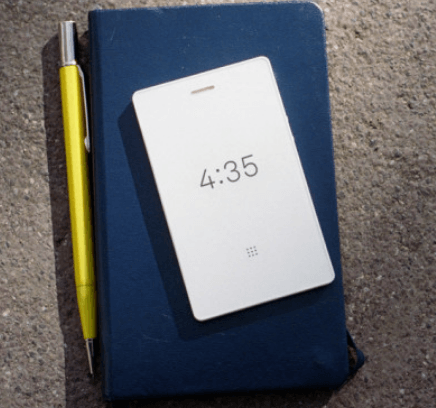The Light Phone is back with a few additional features – an e-ink display and a few essentials tools. The Light Phone 2 finds its place somewhere between its predecessor and current smartphones. When the first Light Phone was created, the idea was to offer a basic phone stripped of all the distracting and superfluous features – internet, texting, email, and photography.
The Light Phone 2 comes with a matte finish e-ink display stretched on the front. The e-ink display can show texts and can be used as a virtual keyboard for sending messages, show contacts, set alarms and other regular features. Sitting on its proprietary operating system, the phone offers a full-fledged text option, but is limited on other options and features.
About the hardware of the new handset, Light—the company behind the Light Phone—says it is more durable than before. Although the final design is yet to be finalized, the company is focusing on the aluminum body and waterproofing support, notes SlashGear.
Light Phone 2 seems to be somewhat inspired by the iPhone on the design front. Just like the iPhone, the power button on the Light Phone 2 is placed on the top and a microphone near the top of the display. On the bottom, it has a headphone jack, a USB-charging port and another microphone. A user can navigate through the menu options with the physical keys on the side of the phone.
The Light Phone 2 supports 4G LTE connectivity and comes with USB-C for charging along with a higher-resolution e-ink screen to make reading easier when outdoors. The handset sports a 500 mAh battery, which the company claims is enough to keep it running for up to five days of standby or “a few hours” of talk-time.
Since the company hasn’t yet finalized the handset and is also holding an Indiegogo crowd-sourcing campaign, there could be more features coming such as directions, playlists, ride-sharing specific apps, weather reports and voice commands. According to the company, these additional features would be on top of the basic features such as contact book, alarm and auto-reply features. Whether or not these new features get added would largely depend on the feedback.
However, if all those features find a space in the Light Phone 2, which is already said to command an active e-ink display, the handset would be well on the path to become a full-fledged smartphone rather than “just a phone.” Creators, on the other hand, are crystal clear about the features they are not going to add, such as social media, emails, advertising or news features, notes TechCrunch.
Light was founded by Joe Hollier and Kai Tag. In 2014, they met during a project where they were asked to design smartphone apps at a Google incubator. However, both agreed that there was an overwhelming army of addictive apps on smartphones, and therefore, decided to create a basic phone, which would be used as minimally as possible.
According to the analytics firm Flurry, daily smartphone use in the US per person is five hours per day. A separate study from the tech support firm Asurion states that Americans check their phones 80 times a day on average. For most of the times, it is for the popular apps such as Facebook, Snapchat and Twitter. The impact of these apps is so much that Silicon Valley parents are focused on raising their kids to be tech-free, notes Business Insider.
The Light Phone is designed to ensure that people can go out “Light” leaving their smartphone at home, and thus, experience the world around them. Both the co-founders wanted to direct the users towards a digital free world for a while.
“By allowing you to leave behind your smartphone, it encourages you to spend quality time doing the things you love the most, free of distraction. We call this ‘going light,’” the company says. Users can synch their other phone with the Light Phone to receive and make calls, or can set an auto-reply on their other phone. The Light Phone does not require a carrier as the phone uses a nano-SIM card.
The Light Phone 2 is expected to be shipped by April of next year. The handset will retail for $400, but is available on Indiegogo for $250. The original Light Phone, which was launched on Kickstarter in 2015, sold about 10,000 units, the company said.





